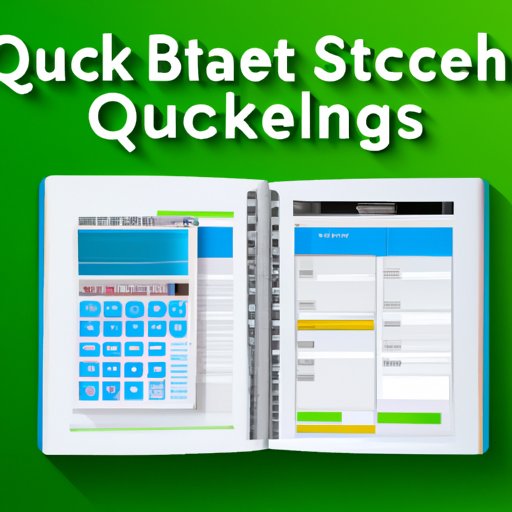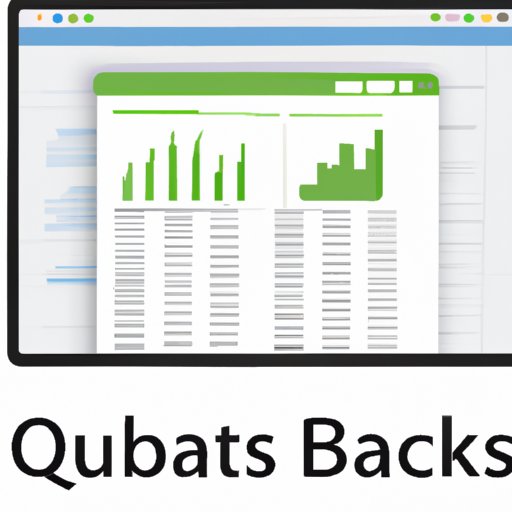Introduction
Financial statements are documents that provide an overview of the financial health of a business. They provide insights into the company’s assets, liabilities, equity, income, expenses, and cash flow. The purpose of financial statements is to provide a snapshot of the company’s financial position at a given point in time.
Step-by-Step Guide to Creating Financial Statements in QuickBooks
Creating financial statements in QuickBooks is relatively straightforward. It involves four main steps: setting up a chart of accounts, entering transactions, generating financial reports, and analyzing the reports. Let’s take a look at each of these steps in detail.
Setting Up a Chart of Accounts
The first step in creating financial statements in QuickBooks is to set up a chart of accounts. This is essentially a list of all the accounts in the company’s accounting system. These accounts include assets, liabilities, equity, income, and expenses. Each account should be assigned a unique number or code for easy identification.
Entering Transactions
Once the chart of accounts has been set up, the next step is to enter transactions into the system. This includes recording all the sales, purchases, payments, and other transactions that occur in the course of doing business. It’s important to ensure that all transactions are properly categorized, as this will make it easier to generate accurate financial reports.
Generating Financial Reports
Once all the transactions have been entered into the system, the next step is to generate financial reports. QuickBooks offers several different types of financial reports, including balance sheets, income statements, and cash flow statements. These reports provide insight into the company’s financial performance over a given period of time.

How to Prepare Accurate Financial Statements with QuickBooks
Creating accurate financial statements requires a basic understanding of the different types of financial statements and how they fit together. Here’s a brief overview of the three main types of financial statements: balance sheets, income statements, and cash flow statements.
What is a Balance Sheet?
A balance sheet is a document that provides an overview of the company’s assets, liabilities, and equity. It shows the company’s financial position at a given point in time. The balance sheet must always be balanced, meaning that the total value of the assets must equal the total value of the liabilities and equity.
What is an Income Statement?
An income statement is a document that shows the company’s income and expenses over a given period of time. It also shows the net profit or loss for the period. The income statement is a useful tool for tracking the performance of the business over time.
What is a Cash Flow Statement?
A cash flow statement is a document that shows the company’s cash inflows and outflows over a given period of time. It is used to track the company’s liquidity and is an important tool for managing the company’s finances.
Creating Financial Statements in QuickBooks
Creating financial statements in QuickBooks is relatively straightforward. Once the chart of accounts has been set up and transactions have been entered, the user can generate financial reports with the click of a button. QuickBooks offers several different types of financial reports, including balance sheets, income statements, and cash flow statements.
Tips for Setting Up Financial Statements in QuickBooks
Setting up financial statements in QuickBooks is not difficult, but there are a few tips that can help ensure accuracy and efficiency. Here are some tips to keep in mind when setting up financial statements in QuickBooks:
Setting Up Your Chart of Accounts
The chart of accounts is the foundation of any financial statement. It’s important to set up the chart of accounts correctly in order to ensure accuracy. Make sure that each account is properly coded and labeled so that it’s easy to identify.
Choosing Appropriate Accounting Methods
It’s important to choose an appropriate accounting method when setting up financial statements in QuickBooks. The most commonly used methods are accrual and cash basis accounting. Accrual basis accounting is recommended for businesses that have long-term contracts or inventory, while cash basis accounting is suitable for small businesses with simple transactions.
Using Templates to Create Financial Statements
QuickBooks offers several templates that can be used to create financial statements quickly and easily. These templates can save users time and effort when setting up financial statements. They can also be customized to meet the specific needs of the business.
Generating Useful Financial Reports with QuickBooks
Once the financial statements have been set up, the next step is to generate financial reports. QuickBooks offers several different types of reports, including balance sheets, income statements, and cash flow statements. These reports can provide valuable insights into the financial performance of the business.
Understanding Financial Reports
Before generating financial reports, it’s important to understand what each type of report is and how it can be used. Balance sheets provide an overview of the company’s assets, liabilities, and equity. Income statements show the company’s income and expenses over a given period of time. Cash flow statements show the company’s cash inflows and outflows over a given period of time.
Generating Reports in QuickBooks
Generating financial reports in QuickBooks is relatively straightforward. Once the chart of accounts has been set up and transactions have been entered, the user can generate reports with the click of a button. QuickBooks offers several different types of financial reports, including balance sheets, income statements, and cash flow statements.
Analyzing Financial Reports
Once the financial reports have been generated, the next step is to analyze them. This involves looking for trends, identifying areas of improvement, and making decisions about how to allocate resources. It’s important to understand the data in order to make informed decisions.

Making Sense of Your Financials: A QuickBooks Guide
Creating financial statements in QuickBooks is not difficult, but it does require an understanding of the basics. Here’s a quick guide to getting started with QuickBooks and making sense of your financials:
Reviewing the Basics
Before getting started with QuickBooks, it’s important to review the basics. This includes understanding the different types of financial statements and how they fit together. It also involves setting up a chart of accounts and entering transactions.
Interpreting Financial Reports
Once the financial statements have been created, the next step is to interpret them. This involves looking for trends, identifying areas of improvement, and making decisions about how to allocate resources. It’s important to understand the data in order to make informed decisions.
Utilizing Insights from Financial Reports
The final step is to utilize the insights from the financial reports. This could involve taking action to improve profitability, reducing costs, or investing in new opportunities. It’s important to use the data to make decisions that will benefit the company in the long run.

Creating Financial Statements in QuickBooks: A Comprehensive Guide
Creating financial statements in QuickBooks can be a daunting task. But with the right tools and knowledge, it doesn’t have to be. This comprehensive guide takes you through the process step-by-step, from setting up your chart of accounts to generating and interpreting financial reports.
Overview of the Process
Creating financial statements in QuickBooks involves four main steps: setting up a chart of accounts, entering transactions, generating financial reports, and analyzing the reports. It’s important to understand the basics of each step before getting started.
Setting Up Your Chart of Accounts
The first step in creating financial statements in QuickBooks is to set up a chart of accounts. This is essentially a list of all the accounts in the company’s accounting system. These accounts include assets, liabilities, equity, income, and expenses. Each account should be assigned a unique number or code for easy identification.
Entering Transactions
Once the chart of accounts has been set up, the next step is to enter transactions into the system. This includes recording all the sales, purchases, payments, and other transactions that occur in the course of doing business. It’s important to ensure that all transactions are properly categorized, as this will make it easier to generate accurate financial reports.
Generating Financial Reports
Once all the transactions have been entered into the system, the next step is to generate financial reports. QuickBooks offers several different types of financial reports, including balance sheets, income statements, and cash flow statements. These reports provide insight into the company’s financial performance over a given period of time.
Analyzing & Interpreting Financial Reports
Once the financial reports have been generated, the next step is to analyze them. This involves looking for trends, identifying areas of improvement, and making decisions about how to allocate resources. It’s important to understand the data in order to make informed decisions.
Utilizing Insights from Financial Reports
The final step is to utilize the insights from the financial reports. This could involve taking action to improve profitability, reducing costs, or investing in new opportunities. It’s important to use the data to make decisions that will benefit the company in the long run.
Conclusion
Creating financial statements in QuickBooks can be a daunting task. But with the right tools and knowledge, it doesn’t have to be. This comprehensive guide takes you through the process step-by-step, from setting up your chart of accounts to generating and interpreting financial reports.
(Note: Is this article not meeting your expectations? Do you have knowledge or insights to share? Unlock new opportunities and expand your reach by joining our authors team. Click Registration to join us and share your expertise with our readers.)
